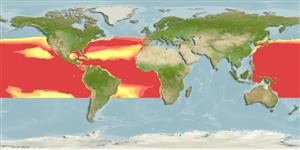Environment: milieu / climate zone / depth range / distribution range
पारिस्थितिकी
समुद्री; गैर प्रवासी; गहराई सीमा 100 - 690 m (Ref. 4479), usually 510 - 550 m (Ref. 96467). Deep-water; 46°N - 27°S, 123°E - 14°E
Eastern Atlantic: Angola. Western Atlantic: Guyana to Brazil. Also known from the Western Pacific.
Length at first maturity / आकार / वज़न / Age
Maturity: Lm ?, range 8 - ? cm
Max length : 9.1 cm SL पुल्लिंग / अलिंग; (Ref. 124495); अधिकतम प्रकाशित वज़न: 10.10 g (Ref. 124495)
High-oceanic, found between 490-690 m during the day and from 100-200 m at night. Specimens larger than 30 mm are non-migratory (Ref. 4479). Mesopelagic (Ref. 58302). Sexual maturity at a length of 7,5 cm (Ref. 47377). In the Atlantic, gravid females were taken in February and April, suggesting a late summer spawning period (Ref. 96467).
Life cycle and mating behavior
परिपक्व अवधि | पुनरुत्पत्ति | मछलीऔ का अंडे देना | अंडे | Fecundity | लार्वा
Hulley, P.A., 1990. Myctophidae. p. 398-467. In J.C. Quero, J.C. Hureau, C. Karrer, A. Post and L. Saldanha (eds.) Check-list of the fishes of the eastern tropical Atlantic (CLOFETA). JNICT, Lisbon; SEI; Paris; and UNESCO, Paris. Vol. 1. (Ref. 4479)
IUCN Red List Status (Ref. 130435)
Threat to humans
Harmless
Human uses
अधिक जानकारी
आम नामउपशब्दचपायचयपरभक्षीईकोटोकसीकोलौजीपुनरुत्पत्तिपरिपक्व अवधिमछलीऔ का अंडे देनाSpawning aggregationFecundityअंडेEgg development
Age/Sizeबाढ़Length-weightLength-lengthLength-frequenciesमौरफोमैटरिक्सआकृति विज्ञानलार्वालारवल गतिकीभर्तीबहुतायतBRUVS
संदर्भजलीयकृषिजलीयकृषि रूपरेखाखींचआनुवंशिकीElectrophoresesहैरेटिबिलटीबीमारीप्रक्रमणNutrientsMass conversion
सहयोगीयोतस्वीरेStamps, Coins Misc.ध्वनिसिगुयटिरारफ्तारतैरने के प्रकारगिल क्षेत्रOtolithsदिमागदृष्टि
साधन
Special reports
Download XML
इंटरनेट स्रोत
Estimates based on models
Preferred temperature (Ref.
123201): 7.6 - 14.9, mean 9.3 °C (based on 44 cells).
Phylogenetic diversity index (Ref.
82804): PD
50 = 0.5078 [Uniqueness, from 0.5 = low to 2.0 = high].
Bayesian length-weight: a=0.00646 (0.00366 - 0.01140), b=3.15 (2.99 - 3.31), in cm total length, based on LWR estimates for this species & (Sub)family-body (Ref.
93245).
Trophic level (Ref.
69278): 3.1 ±0.1 se; based on size and trophs of closest relatives
लौटाव (Ref.
120179): ऊंचा, न्यूनतम जनसंख्या दुगनी समय अवलागत 15 महीने। (Preliminary K or Fecundity.).
Fishing Vulnerability (Ref.
59153): Low vulnerability (10 of 100).
